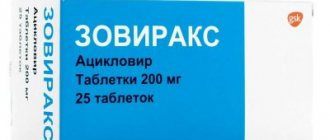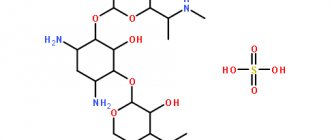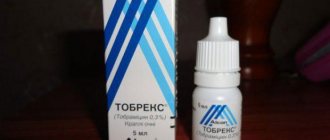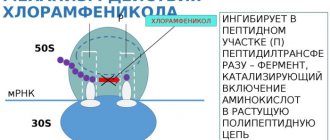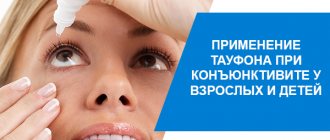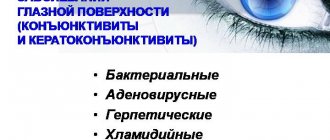Indications for use
The active ingredient of the drug, gentamicin, is a broad-spectrum antibiotic with antibacterial and anti-inflammatory effects.
Dex-gentamicin ointment is prescribed for the treatment of visual organs, with manifestations of allergies, bacterial infection and inflammation associated with the formation of cystic formations on the eyelid.
Gentamicin is an antibiotic that inhibits the activity of bacteria that are insensitive to beta-lactam antimicrobial agents.
The following pathogens are particularly susceptible to the substance Gentamicin:
- staphylococci;
- coli;
- types of streptococci that penetrate the ocular epithelium, which provokes an acute infectious process.
Dexamethasone, the second active ingredient in the ointment, eliminates the negative effects of microbial decay products on the organs of vision and reduces vascular susceptibility. This helps reduce swelling of the eyelid skin and redness of the eye mucosa.
The substance Dexamethasone is not used to relieve acute inflammatory processes, as it reduces the resistance of local immunity. The component is used in combination with an antibiotic, which prevents the proliferation of pathogenic bacteria.
Dexa-Gentamicin is available in the form of an ointment, 2.5 grams in an aluminum tube, and drops, in a plastic bottle, with 5 grams of a transparent liquid substance.
Both forms of the drug include the following active elements:
- gentamicin;
- dexamethasone.
Auxiliary components that enhance the effect of the ointment and preserve the properties of the main substances include:
- white cosmetic Vaseline;
- liquid paraffin;
- lanolin.
Features of application
A strip of the drug no longer than 10 mm is placed into the conjunctival cavity. The procedure is repeated up to three times a day, making sure that the tube does not touch the eye or scratch the skin.
If Gentamicin eye drops are used, the ointment is applied after a quarter of an hour. Therapy lasts approximately three weeks.
After using the drug, vision deteriorates for some time and the psyche is inhibited. After applying Denta-Gentamicin, you cannot immediately go on a flight or work with instruments, since there is a problem with concentration.
Ointment applications should not be applied when treating with Atropine, Cloxacillin, Heparin and some other drugs. In combination with them, intraocular pressure increases, and precipitates form in the conjunctiva.
The ointment is not prescribed for babies or older children. The doctor decides whether expectant mothers can use it after examining the woman, if the use of Dex-Gentamicin is caused by extreme necessity.
Whether farsightedness can be treated in children 1 year of age, find out by following the link.
Ciprofloxacin is a broad-spectrum antibiotic
When Dancil eye drops are prescribed, read here.
Benefits and harms
If an antibiotic and a corticosteroid are taken separately, as two drugs, this does not ensure the compatibility of the substances and does not guarantee their mutual complementarity. These disadvantages do not exist when combining Dexamethasone and Gentamicin, and both substances work in the same direction. The possibility of overdose is minimal, and the elements in the drug are dosed so that the antibiotic is supported by a glucocorticosteroid.
Possible harm includes the effect of gentamicin, which, like most antibiotics, has a negative effect on a number of functional capabilities of the human body:
- From the nervous system: headache, deterioration of motor skills, increased fatigue, hearing loss. There is evidence that taking gentamicin-based drugs leads to the development of hearing loss.
- From the digestive system: when exposed to the gastrointestinal mucosa, cases of nausea and vomiting are possible.
- From the side of the liver. It is possible to increase the number of liver enzymes that are involved in the biotransformation of amino acids. In some cases, there is an increase in the level of bilirubin in the blood.
- From the urinary system. Excretion of gentamicin occurs through the kidneys, which means damage to the structural elements of the filtration organs is possible. In this case, gentamicin encounters the body’s immune defense reaction, which perceives the antibacterial agent as a hostile foreign substance. When trying to eliminate the influence of a foreign element, the immune system also damages the kidney structure. In rare situations, acute renal failure may develop.
- From the circulatory system. An excess of antibiotic leads to toxic poisoning. Its manifestations in painful and unstable conditions of the body: anemia (a drop in the level of red blood cells and a decrease in hemoglobin), leukopenia (weakened immunity due to a decrease in leukocytes in the blood), granulocytopenia (a decrease in the number of neutrophils).
- From allergic manifestations. Irritation of the eyelid, itching, and redness occur with repeated application of a product that contains gentamicin. Rare cases of angioedema, with nausea, acute pain in the abdomen, and vomiting, deserve special attention.
Prescribing ointment for adults
Dex-Gentamicin ointment is prescribed for adults with the following symptoms:
- the occurrence of inflammation in the form of swelling in the lower or upper eyelid of the eye;
- painful sensations when pressing on the site of inflammation or when blinking;
- swelling of the eyelids, spreading to the bridge of the nose and the area under the eyes;
- signs of toxic poisoning associated with the use of other drugs.
These signs indicate the occurrence of cold or regular barley. The use of gentamicin ointment occurs after detection of primary symptoms. For further schedule of course treatment, consult a doctor.
Methods of using dex-gentamicin ointment in adults:
- up to 1.5 g of ointment is squeezed into the conjunctival sac of the diseased eye. Depending on the extent of the infection, applications are made 2 to 4 times a day;
- with a high degree of eye damage, the frequency of applications is permissible after three hours on the fourth, until visible improvements occur; after 2-3 days, the use of the ointment becomes standard.
If the doctor has prescribed the parallel use of ointment and eye drops, instillations occur first, and after 5-10 minutes the ointment is used.
https://medglaza.ru/aptechka/mazi/deksa-gentamitsin-instruktsiya.html
Dexa-Gentamicin eye ointment 2.5g tube 39255
Description
Dexa-Gentamicin Ursapharm Arzneimittel GmbH (Germany) eye ointment; aluminum tube 2.5 g, cardboard pack 1; EAN code: 4031626710086; No. P N015080/02, 2008-07-31 from Ursapharm Arzneimittel GmbH (Germany) Latin name Dexa-Gentamicin Active ingredient Gentamicin* + Dexamethasone* (Gentamycinum+ Dexamethasonum) ATC: D07CB04 Dexamethasone in combination with antibiotics Pharmacological groups Glucocorticosteroid for topical use + antibiotic -aminoglycoside [Glucocorticosteroids in combinations] Glucocorticosteroid for topical use + antibiotic aminoglycoside [Ophthalmic drugs in combinations] Nosological classification (ICD-10) H00 Hordeolum and chalazionH01.0 BlepharitisH10 ConjunctivitisH10.1 Acute atopic conjunctivitisH10.8 Other conjunctivitisH 10.9 Conjunctivitis, unspecifiedH16 KeratitisT88 Other complications of surgical and therapeutic interventions, not classified in other headingsZ100* CLASS XXII Surgical practiceZ98 Other postoperative conditions Description of the dosage form Ointment: white, with a yellowish tint, translucent. Pharmacological action Pharmacological action - glucocorticoid, broad-spectrum antibacterial, antiallergic, bactericidal, anti-inflammatory. Pharmacodynamics A combined drug whose effect is determined by its constituent components. It has antiallergic, anti-inflammatory and antibacterial effects. Dexamethasone - GCS - has a pronounced anti-inflammatory effect, the index of its relative anti-inflammatory activity is 30. Gentamicin sulfate - an antibiotic of the aminoglycoside group - is characterized by a wide spectrum of action, active against most gram-negative and gram-positive microorganisms (Pseudomonas aeruginosa, Escherichia coli, Proteus spp., Klebsiella spp. ., Serratia spp., Salmonella spp.). Moderately active against strains of Staphylococcus spp. Pharmacokinetics When applied topically, dexamethasone penetrates well into the corneal epithelium and conjunctiva; at the same time, therapeutic concentrations are achieved in the aqueous humor of the eye; with inflammation or damage to the mucous membrane, the penetration rate increases. Gentamicin sulfate, when applied topically, is found in therapeutic concentrations in the corneal stroma, in the anterior chamber humor, and vitreous body within 6 hours. Gentamicin sulfate does not penetrate into the systemic circulation through intact corneal epithelium. Indications for the drug Dex-Gentamicin: infections of the anterior segment of the eye caused by microflora sensitive to gentamicin (conjunctivitis, keratitis, blepharitis, barley); allergic processes in the anterior segment of the eye, accompanied by bacterial infection; prevention and treatment of inflammatory phenomena in the postoperative period (cataract removal, antiglaucomatous operations). Contraindications: hypersensitivity to any of the components of this drug; keratitis caused by Herpes zoster (dendritic keratitis), chickenpox and other viral diseases of the cornea and conjunctiva; mycobacterial eye infections; fungal eye diseases; acute purulent eye diseases with damage to the corneal epithelium; corneal epitheliopathy; injuries and ulcerative lesions of the cornea; wearing contact lenses; increased intraocular pressure; I trimester of pregnancy; children under 18 years of age (due to the lack of data on effectiveness and safety). Use during pregnancy and lactation To date, there are no clinical trial data regarding the use of Dex-Gentamicin during pregnancy, lactation, or in children. However, the drug can be used in the II–III trimester of pregnancy if the expected benefit to the mother outweighs the possible risk to the fetus. Side effects In rare cases, after applying the ointment, an allergic reaction and burning sensation are possible. Long-term use of the drug can cause secondary glaucoma and steroid cataracts, therefore, when using the drug for more than 2 weeks, as well as in patients with a history of glaucoma, it is recommended to regularly monitor intraocular pressure. Contact dermatitis, herpetic keratitis, corneal perforation in the presence of keratitis, fungal infection, increased severity of bacterial infection of the cornea, ptosis, mydriasis may occur. When used after corneal injuries, it may slow down its healing. If side effects occur, you should stop using the drug and consult an ophthalmologist as soon as possible. Interaction When used together with atropine, other anticholinergic or mydriatic drugs, an increase in the level of intraocular pressure is possible. When applied topically, gentamicin is incompatible with amphotericin B, heparin, sulfadiazine, cephalothin and cloxacillin. Topical use of these drugs together with gentamicin may lead to the deposition of precipitates in the conjunctival cavity. Overdose When using the drug Dex-Gentamicin ophthalmic ointment topically, an overdose is unlikely. Special instructions Impact on the ability to drive vehicles and operate machinery. Immediately after applying Dex-Gentamicin ophthalmic ointment, a short-term disturbance in visual acuity may occur, leading to a slowdown in mental and physical reactions. Therefore, it is not recommended to use the drug immediately before working with machinery or driving vehicles. For 30 minutes after application, you must refrain from activities that require increased attention. Release form Eye ointment. In aluminum tubes with a PE tip and a screw cap, 2.5 g each. 1 tube in a cardboard box. Manufacturer: Ursafarm Artsneimittel GmbH. Industriestrasse 35, 66129 Saarbrücken, Germany. Tel.: +49 (0) 6805-92 92-0. Send claims regarding the quality of the drug to the representative office address: 107996, Moscow, st. Gilyarovskogo, 57, building 4. Tel./fax: (495) 684-34-43. e-mail Conditions for dispensing from pharmacies By prescription. Storage conditions for the drug Dexa-Gentamicin At a temperature not exceeding 25 °C. Keep out of the reach of children. The shelf life of the drug Dexa-Gentamicin is 3 years. After opening - 4 weeks. Do not use after the expiration date indicated on the package. 2000-2015. Register of Medicines of Russia The database is intended for healthcare professionals. Commercial use of materials is not permitted.
Possible product names
- Dexa-Gentamicin eye ointment 2.5g tube
- DEXA-GENTAMYCIN OCHL. OINTMENT 2.5
- DEXA-GENTAMICIN 2.5 HL OINTMENT
- DEXA-GENTAMICIN OINTMENT GL. TUBE 2.5G
- DEXA-GENTAMICIN GL. OINTMENT 2.5G TUBE
- (Dexa-Gentamicin) Dexa-Gentamicin eye ointment 2.5g tube
Possible contraindications for the patient
The drug Dex-Gentamicin, like all medicines containing an antibiotic, has contraindications that take into account the chronic or acute condition of the patient, the presence of allergic reactions or painful pathologies.
This:
- chickenpox (chickenpox);
- fungal infection of the body;
- mycobacterial infections of the organs of vision;
- dendritic keratitis;
- pustular formations with damage to the corneal epithelium of the eye;
- high intraocular pressure;
- individual intolerance to the components of the drug;
- pregnancy in the first three months of pregnancy;
- age of patients under 18 years (excluding prescriptions of a doctor who takes responsibility for the negative effects of the drug).
You should not wear contact lenses after applying gentamicin ointment. If it is not possible to stop wearing lenses, it is recommended to use Dex-gentamicin drops instead of ointment.
After instilling eye drops, putting on lenses is allowed no earlier than twenty minutes later.
The use of gentamicin affects the nervous system of individual people. Limit work in high-risk areas and driving vehicles for the period the ointment is active (six hours after application).
Instructions for use
The instructions for use recommend using Dex-Gentamicin eye ointment as prescribed by an ophthalmologist. The drug is included in treatment regimens after a series of studies.
It is not advisable to use it in case of an allergic reaction that does not occur against the background of bacterial infection. This will cause excessive pharmacological load and delay full recovery.
Also, Dex-Gentamicin is not used in patients if eye pathology is caused by viruses or fungi. There will be no therapeutic effect, which will lead to the spread of the disease to healthy tissues .
Indications and contraindications
The ophthalmic agent is prescribed to patients with ocular infectious and inflammatory pathologies. It is included in therapeutic regimens when diagnosing keratitis, conjunctivitis, and barley.
The drug is also used as a prophylactic agent in the postoperative period.
Dex-Gentamicin eye ointment for chalazion can be used on the recommendation of an ophthalmologist. The doctor prescribes it to patients when a concomitant bacterial infection is detected. The drug has been proven to be highly effective in the treatment of allergies complicated by the penetration of pathogenic bacteria into the mucous membrane.
The ointment is not used in the following cases:
- increased intraocular pressure;
- mycobacterial eye infection;
- ophthalmological pathologies caused by viruses or pathogenic fungi;
- eye diseases accompanied by the formation of pus and damage to the cornea;
- individual intolerance to the active and auxiliary ingredients of the drug.
Relative contraindications to the use of the product are those under 18 years of age. Dexa-Gentamicin can be prescribed to these categories of patients only if absolutely necessary. This is also true during pregnancy and lactation.
Directions for use and doses
Single and daily dosages, as well as the duration of the therapeutic course, are determined by the doctor.
It takes into account the stage of eye pathology, the presence of other diseases in the anamnesis, and the number of complications that have arisen. According to the instructions, the product is used up to 3 times a day by placing it behind the lower eyelid. It is recommended to massage it lightly to distribute Dex-Gentamicin evenly.
Side effects and special instructions
When treating conjunctivitis and barley with Dex-Gentamicin, local systemic manifestations are possible. The instructions for use provide a list of signs of side effects of the ointment. These are redness of the eyes, swelling of the eyelids, lacrimation, rash, increased dryness of the mucous membranes, itching.
Long-term treatment with a combination drug sometimes leads to the development of glucocorticosteroid cataracts and secondary glaucoma.
During the therapeutic course, wearing contact lenses is not recommended. The simultaneous use of other ophthalmic agents with Dex-Gentamicin should be avoided. The time interval between their applications should be at least 15 minutes.
Side effects of the drug
In the practice of using gentamicin-based products, there are side effects associated with the increased sensitivity of the skin epithelium to antibiotics of this group:
- allergic symptoms: rash, itching, redness;
- short-term burning sensation;
- herpetic keratitis;
- fungal infection of the organs of vision;
- mydriasis
Dexa-Gentamicin should be used with caution for glaucoma. If your doctor has prescribed this medicine in combination with antiglaucoma treatment, check with your ophthalmologist for a schedule for measuring eye pressure.
The combined use of gentamicin ointment with atropine (when checking the condition of the eye vessels) increases intraocular pressure.
The risk of deposition of precipitates in the conjunctival bursa precludes the use of gentamicin in combination with sulfadiosin, amphotericin B, cephalothin, and heparin.
The drug is dispensed from city pharmacies without a prescription. It is recommended to find out its availability at the pharmacy before you go shopping. You can order Dex-Gentamicin on official websites on the Internet. The price of the medicine is lower than at retail.
Analogs
The medication does not have equivalent analogues, but it is possible to replace it with other drugs that have the same principle of action:
- Maxitrol. An ointment with a combined effect that has antibacterial, anti-inflammatory and antiallergic effects. The drug contains a glucocorticosteroid and two antibiotics that are active against most pathological bacteria that cause eye diseases. A list of antibacterial eye drops for children can be found on our website.
- Prednisolone. A drug used in the treatment of eye diseases that are based on inflammatory processes. In some cases, it is used as an enhancer of tissue regeneration in case of injury to the visual system. Reviews of Vigamox drops can be found here.
Dex-Gentamicin ophthalmic ointment is available from pharmacies with a doctor's prescription. Its use should be started only after the appointment of a specialist; independent treatment can be fraught with unpleasant consequences.
The organs of vision, as well as other organs of the human body, need regular examination and proper treatment, therefore, at the first signs of discomfort in this area, you should consult an ophthalmologist.
How to use it for chalazion
Despite the similarity of names, cold barley (chalazion) differs from the usual one in the nature of its course and methods of getting rid of it.
A chalazion is a blockage of the mabonite sebaceous gland. With the standard development of barley, the pineal formation matures for some time, after which the separation of pus is provoked and the complete release of the purulent plug is controlled.
Cold barley is not able to break through, and even the beginning of the separation of purulent substance from the sebaceous canal does not mean emptying of the chalazion. Next to the inflamed gland there is also an infiltrate and a capsule, in which the content of pus does not decrease when it leaves the meibonite gland. It is impossible to provoke the release of pus by applying pressure during a chalazion!
The formation of a chalazion does not depend on the introduction of infection or viruses into the body. Cell proliferation is random. Dex-Gentamicin ophthalmic ointment is used for chalazion due to the action of the antibiotic. The course of treatment is prescribed by the doctor individually.
In combination with the use of gentamicin ointment, dry heating of the chalazion, taking biologically active additives (brewer's yeast), and vitamins B1, B6, B12 are recommended.
An effective method for treating barley
Barley, in addition to the fact that it appears in the form of a chalazion, also differs according to the principle of condition:
- chronic, or old barley;
- spicy barley.
Old barley is recognized by its recurrent course. This type of disease leads to a gradual decrease in visual acuity, damage to the eyelash follicles until the eyelashes completely fall out, the formation of scaly growths on the eyelid, tearing and chronic eye fatigue.
Self-prescription and voluntary use of Dex-Gentamicin ointment for chronic barley are not allowed - application corresponds to the schedule of a detailed therapeutic regimen.
Gentamicin ointment is prescribed for application into the conjunctival sac 2 to 4 times a day by application in a thin layer. If mucus or pus is found on the eyelid and eyelashes before applying the ointment, you need to clean them with a dry cotton pad. The course lasts from one week to three.
In case of a purulent form of the disease, until the first signs of improvement, an intensive course of treatment with ointment is recommended. Apply after three hours (excluding nighttime sleep).
If a doctor prescribes two local remedies, it is necessary to observe time intervals of 15-20 minutes between the administration of medications.
Do not touch the nose of the metal tube to the cornea of the eye when applying the ointment.
Application for children
The use of Dex-Gentamicin ophthalmic ointment for children is justified by prolonged exposure to the drug. In the case of instillation with eye drops, the retention effect of the product on the skin is lower. Reduce the discomfort from using the ointment and extend the period of its retention on the sore eyelid, perhaps applying the application before putting the child to bed.
When using Dex-Gentamicin ointment for a child, the disadvantages associated with the use of eye ointments are taken into account:
- absorption of the active substance occurs more slowly than with instillation of drops;
- in case of purulence of the eyes, the ointment will be ineffective, purulent crusts are removed from the eyelashes and eyelids before application is made;
- in rare situations, the development of an infection cannot be stopped with the help of an ointment, since there have been cases when the pathogenic microbial environment has adapted in the formative substance of the drug and provoked a secondary outbreak of the disease.
Dex-Gentamicin ointment is not used in children under 18 years of age due to an unknown reaction of a fragile child's body to antibiotics of this group. Prescription is possible under the responsibility of a physician and under strict control of eye pressure.
Compound
dexa-gentamicin eye ointment
Dex-Gentamicin eye ointment has a specific release form: usually an aluminum tube with a volume of 2.5 ml. The drug contains gentamicin sulfate (0.3 mg per 1 g) and dexamethasone (0.3 mg per 1 g). The excipients are lanolin, white petroleum jelly and liquid paraffin.
Alphagan eye drops are used as a conservative treatment for glaucoma.
Analogs of this medication
There are no complete analogues of Dex-Gentamicin ophthalmic ointment that would contain a combination of the same active components. But there are a number of drugs that are similar in pharmacological action.
The well-known pharmacy doctor Tobradex
Tobradex is prescribed to stop the development of bacterial infection. Dexamethasone in the composition is responsible for relieving inflammation and mildly relieving allergic manifestations.
The antibiotic tobramycin prevents the proliferation of microbes and reduces the scope of inflammation, localizing it at the site of the lesion.
The medicine is used to restore damage to the eyelids after surgery, for blepharitis and conjunctivitis.
